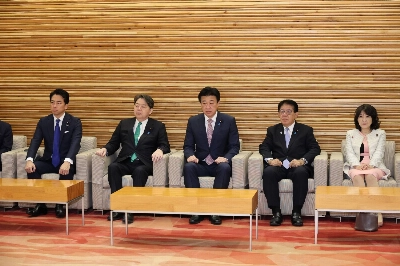While Japan has made some progress in expanding its offshore wind power, the pace of change is still too slow, says Peter Taksoe-Jensen, Denmark’s ambassador to Japan.
But given Japan’s potential, he suggests the end result of current efforts to push more offshore wind into development could be just like putting ketchup on a hamburger.
“What I’m hoping for is that the effort to increase offshore wind in Japan will produce a ketchup effect, where you try to get the ketchup out of the bottle but nothing much comes out until suddenly it does, after much effort,” Taksoe-Jensen said in a recent interview with The Japan Times.
As part of that effort, he said, Japan should look to more floating offshore wind in its exclusive economic zones (EEZ) and consider the establishment of a new innovation center in the country to address all of the issues surrounding the development and deployment of offshore wind power.
Denmark has turned to offshore wind to achieve its greenhouse gas emissions reduction target of 70% in 2030, based on 1990 levels, and net zero emissions by 2045. The country expects offshore wind to provide 12 to 13 gigawatts of its energy by 2030, up from about 2.3 GW today.
Meanwhile, Japan has plans for 10 GW of offshore wind by 2030 and 30 GW to 45 GW by 2040. But the problem, Taksoe-Jensen says, is that time is running out for the world to make the switch to more sustainable sources of energy, which is key to achieving the 2030 carbon reduction goals and reaching net-zero carbon emissions by 2050.
Japan has pledged a 46% reduction in greenhouse gas emissions by 2030 and net-zero emissions by 2050. Renewable energy is expected to account for 36% to 38% of the energy mix by 2030. But coal will still be used and is expected to provide about 20%.
The Danish ambassador believes that in order to meet its 2030 decarbonization pledges, Japan must tap into its offshore wind potential and attract investments from overseas.
“We’ve heard the real potential in Japan for offshore wind is 500 GW, if it were all to be realized,” he said.
Much of this potential lies in Japan’s exclusive economic zone. While Japan has about 380,000 square kilometers of land, the combined area of its territorial seas and EEZs is about 4.47 million square kilometers, the sixth largest in the world.
To expand that potential and attract the interest of Danish offshore wind investment, for example, the ambassador notes that a couple of things have to happen.
“First, the Japanese government has to enact the necessary legislation to open up its EEZ to offshore wind development, and I think this will happen. Second, it needs to adopt two tracks for offshore wind development. The first track is continuing to install bottom-fixed wind turbines. The second track is building larger scale, floating offshore wind projects in the EEZ,” Taksoe-Jensen said.
But further wind power development faces numerous hurdles that have slowed its development in Japan, such as cost, a lack of innovation, and regulatory and environmental concerns.
To address these issues, Taksoe-Jensen has proposed to METI that a new international innovation center for floating offshore wind power be set up in Japan.
“You don't have a place where you can tackle the issues one by one,” he said.
The ambassador envisions the center doing research on issues ranging from how to manage the regulatory framework for offshore floating wind power to how to protect marine mammals and the natural environment near the turbines.
He also sees researchers examining different possible floating offshore wind business models to find the best ways to run the projects. Local authorities, such as those from Hokkaido, he added, would also be part of the center. The result would, the ambassador said, hopefully change the attitudes of those who believe that developing offshore wind is difficult.
“There are many things that need to be done," Taksoe-Jensen said. "It's not that there's no solution. It's more a question of changing the mindset.”




















With your current subscription plan you can comment on stories. However, before writing your first comment, please create a display name in the Profile section of your subscriber account page.